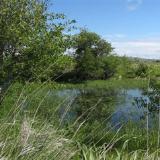 © Pete Saloutos/Panoramic Images (Washington Title Image Large)
© Pete Saloutos/Panoramic Images (Washington Title Image Large)

Columbia Plateau Vegetation
The Columbia Plateau is dominated by shrub-steppe, like much of the Great Basin. This is a once expansive habitat of shrubs, forbs and bunchgrass. Aromatic shrubs such as sagebrush and bitterbrush offer good browsing to a wide range of wildlife, from sage grouse and pygmy rabbits to mule deer and Rocky Mountain elk.
Other plant communities can be found in this semi-arid region, including salt desert scrub and native grasslands.
Native grasslands remain in scattered pockets of the Palouse and in some canyons. In other areas, grasslands have been created by fire and agricultural operations. Throughout the ecoregion, cheatgrass and other invasive species have displaced native forbs and bunchgrasses.
Forests of ponderosa pine and Douglas-fir grow where the foothills of the Columbia Plateau meet the surrounding mountain ranges.
In much of the Columbia Plateau, a living cryptobiotic crust of blue green algae, lichens, and mosses protects and enriches the soil. The importance of this layer, which shields soils from erosion and fixes nitrogen, is becoming more appreciated. Cryptobiotic crusts face threats from livestock trampling, off-road vehicle traffic, and invasive weeds.
Herbaceous wetlands, such as potholes, marshes, and wet meadows, are found throughout the Columbia Plateau. Their aquatic plants, rushes, and thickets of shrubs constitute another conservation priority.
The plateau’s riparian areas and wetlands are other habitats high on the conservation radar. Floodplain cottonwood groves; shrubby stream banks of willow, red-osier dogwood, and mock orange; potholes; marshes; and gravelly river channels offer habitat to a great range of fish and wildlife while occupying only a small area. Invasive species such as Russian olive and purple loosestrife alter their function and habitat value.
Overall, the ecoregion is richly endowed with flora, hosting 46 plant community alliances and roughly 450 plant community associations. The Washington Natural Heritage Program regards more than 20% of these associations as vulnerable. Shrub-steppe and the interior grasslands are considered by many to be among the highest conservation priorities in the ecoregion.
According to NatureServe, eighteen endemic plant species occur with the Columbia Plateau ecoregion.
The floristic richness of the Columbia Plateau is still being discovered. Species new to science, like Umtanum desert buckwheat and White Bluffs bladderpod, were found as recently as the mid-1990s.
For details of this ecoregion within Washington, click a subheading in the left column.
View the more general description of this ecoregion in North America
Cryptobiotic crust: A highly specialized community of cyanobacteria, mosses, lichens, and their by-products, which create a crust of soil particles bound together by organic materials. >back
Forb: A broad-leaved herb or forage plant other than a grass. >back
Shrub-steppe: Grassland with a shrub component. In Washington the shrubs are often, but not exclusively, species of sagebrush. more> (external site) >back



